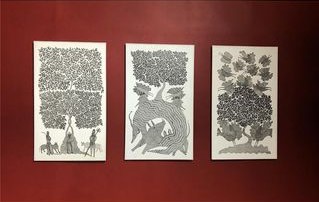
EARTH WARRIOR A SHOW OF INDIAN FOLK AND TRIBAL ART FOR WORLD ENVIRONMENT DAY
India has a vast treasure of folk and tribal art forms, each possessing distinct cultural and regional characteristics. The highly symbolic Madhubani paintings, the ritualistic Pithora art of the Rathwa tribe, the engaging simplicity of Warli art, the sinuous lines of Kalighat paintings, the compelling stories of Rajasthani phads and West Bengal patachitras – these are just a few of India’s many folk and tribal art treasures. These art forms serve many functions – social, ritualistic, religious, story-telling, educational, entertainment. These paintings were means of visual education, a way of passing down stories, myths and social values from one generation to another. Above all, these art forms are very beautiful and aesthetic expressions of human creativity.
At the heart of most folk and tribal art traditions is the deep sense of respect for Mother Earth. These communities live in total harmony with the forces of Nature and worship our blue planet as a mother. Folk and tribal art in India reflects the inter-connectedness of all life forms on earth. These artists have a legacy of using eco-friendly materials with great beauty and felicity to create objects for daily use, veneration and contemplation. In most folk and tribal art traditions, even the colours are painstakingly extracted from roots, shoots, leaves and flowers and then mixed with a fruit glue to form bright hues. Through their art, the folk and tribal artists communicate a sense of reverence for Nature and for all life-forms.
Today, our country is plagued by the problem of garbage and litter. India is practically choking on the vast amounts of plastic waste generated in the country. Our fields and roads lie submerged in plastic garbage, our waterways and rivers are choked with plastic debris and everywhere you look there is more plastic trash to see. Our air, land and water are heavily polluted and we need to look for solutions, especially when it comes to taking personal responsibility for the state of the environment.
This show proposes to look at the issue of environmental pollution as seen by the folk and tribal artists of India whose lives traditionally were very earth-friendly. How do these artists respond to the scourge of plastic pollution that is now a part of our daily lives in India? How do they depict their concern for the environment through their art? What remedies or alternative use for plastics do these artists with their deep roots in pro-earth living have to offer?
Artists from various traditions – Gond, Madhubani, Jogi, Kalighat, pattachitra as well as sculptors in paper-mache and terracotta and wood have been invited to participate in this show. Artists from tribal communities in Northeast India are also being invited to create works based on their native skills- basketry and weaving – for this show.
Display View
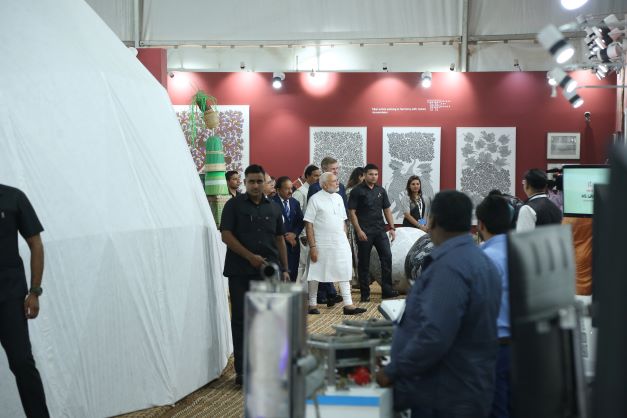
EARTH WARRIOR, A SHOW OF INDIAN FOLK AND TRIBAL ART FOR WORLD ENVIRONMENT DAY
India has a vast treasure of folk and tribal art forms, each possessing distinct cultural and regional characteristics. The highly symbolic Madhubani paintings, the ritualistic Pithora art of the Rathwa tribe, the engaging simplicity of Warli art, the sinuous lines of Kalighat paintings, the compelling stories of Rajasthani phads and West Bengal patachitras – these are just a few of India’s many folk and tribal art treasures. These art forms serve many functions – social, ritualistic, religious, story-telling, educational, entertainment. These paintings were means of visual education, a way of passing down stories, myths and social values from one generation to another. Above all, these art forms are very beautiful and aesthetic expressions of human creativity.
At the heart of most folk and tribal art traditions is the deep sense of respect for Mother Earth. These communities live in total harmony with the forces of Nature and worship our blue planet as a mother. Folk and tribal art in India reflects the inter-connectedness of all life forms on earth. These artists have a legacy of using eco-friendly materials with great beauty and felicity to create objects for daily use, veneration and contemplation. In most folk and tribal art traditions, even the colours are painstakingly extracted from roots, shoots, leaves and flowers and then mixed with a fruit glue to form bright hues. Through their art, the folk and tribal artists communicate a sense of reverence for Nature and for all life-forms.
Today, our country is plagued by the problem of garbage and litter. India is practically choking on the vast amounts of plastic waste generated in the country. Our fields and roads lie submerged in plastic garbage, our waterways and rivers are choked with plastic debris and everywhere you look there is more plastic trash to see. Our air, land and water are heavily polluted and we need to look for solutions, especially when it comes to taking personal responsibility for the state of the environment.
This show proposes to look at the issue of environmental pollution as seen by the folk and tribal artists of India whose lives traditionally were very earth-friendly. How do these artists respond to the scourge of plastic pollution that is now a part of our daily lives in India? How do they depict their concern for the environment through their art? What remedies or alternative use for plastics do these artists with their deep roots in pro-earth living have to offer?
Artists from various traditions – Gond, Madhubani, Jogi, Kalighat, pattachitra as well as sculptors in paper-mache and terracotta and wood have been invited to participate in this show. Artists from tribal communities in Northeast India are also being invited to create works based on their native skills- basketry and weaving – for this show.
Display View
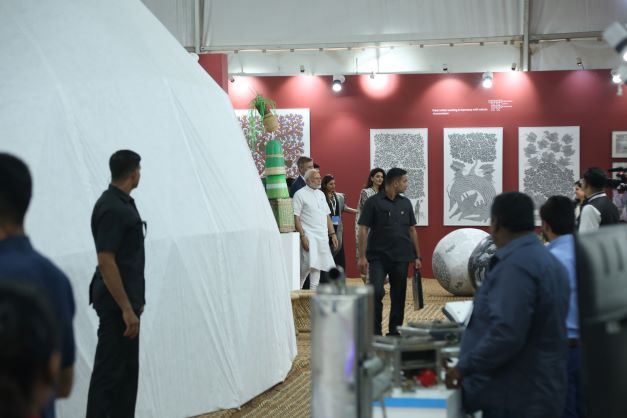
EARTH WARRIOR, A SHOW OF INDIAN FOLK AND TRIBAL ART FOR WORLD ENVIRONMENT DAY
India has a vast treasure of folk and tribal art forms, each possessing distinct cultural and regional characteristics. The highly symbolic Madhubani paintings, the ritualistic Pithora art of the Rathwa tribe, the engaging simplicity of Warli art, the sinuous lines of Kalighat paintings, the compelling stories of Rajasthani phads and West Bengal patachitras – these are just a few of India’s many folk and tribal art treasures. These art forms serve many functions – social, ritualistic, religious, story-telling, educational, entertainment. These paintings were means of visual education, a way of passing down stories, myths and social values from one generation to another. Above all, these art forms are very beautiful and aesthetic expressions of human creativity.
At the heart of most folk and tribal art traditions is the deep sense of respect for Mother Earth. These communities live in total harmony with the forces of Nature and worship our blue planet as a mother. Folk and tribal art in India reflects the inter-connectedness of all life forms on earth. These artists have a legacy of using eco-friendly materials with great beauty and felicity to create objects for daily use, veneration and contemplation. In most folk and tribal art traditions, even the colours are painstakingly extracted from roots, shoots, leaves and flowers and then mixed with a fruit glue to form bright hues. Through their art, the folk and tribal artists communicate a sense of reverence for Nature and for all life-forms.
Today, our country is plagued by the problem of garbage and litter. India is practically choking on the vast amounts of plastic waste generated in the country. Our fields and roads lie submerged in plastic garbage, our waterways and rivers are choked with plastic debris and everywhere you look there is more plastic trash to see. Our air, land and water are heavily polluted and we need to look for solutions, especially when it comes to taking personal responsibility for the state of the environment.
This show proposes to look at the issue of environmental pollution as seen by the folk and tribal artists of India whose lives traditionally were very earth-friendly. How do these artists respond to the scourge of plastic pollution that is now a part of our daily lives in India? How do they depict their concern for the environment through their art? What remedies or alternative use for plastics do these artists with their deep roots in pro-earth living have to offer?
Artists from various traditions – Gond, Madhubani, Jogi, Kalighat, pattachitra as well as sculptors in paper-mache and terracotta and wood have been invited to participate in this show. Artists from tribal communities in Northeast India are also being invited to create works based on their native skills- basketry and weaving – for this show.
Display View
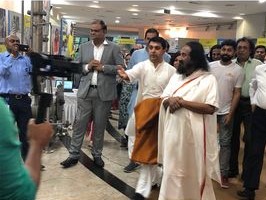
EARTH WARRIOR, A SHOW OF INDIAN FOLK AND TRIBAL ART FOR WORLD ENVIRONMENT DAY
India has a vast treasure of folk and tribal art forms, each possessing distinct cultural and regional characteristics. The highly symbolic Madhubani paintings, the ritualistic Pithora art of the Rathwa tribe, the engaging simplicity of Warli art, the sinuous lines of Kalighat paintings, the compelling stories of Rajasthani phads and West Bengal patachitras – these are just a few of India’s many folk and tribal art treasures. These art forms serve many functions – social, ritualistic, religious, story-telling, educational, entertainment. These paintings were means of visual education, a way of passing down stories, myths and social values from one generation to another. Above all, these art forms are very beautiful and aesthetic expressions of human creativity.
At the heart of most folk and tribal art traditions is the deep sense of respect for Mother Earth. These communities live in total harmony with the forces of Nature and worship our blue planet as a mother. Folk and tribal art in India reflects the inter-connectedness of all life forms on earth. These artists have a legacy of using eco-friendly materials with great beauty and felicity to create objects for daily use, veneration and contemplation. In most folk and tribal art traditions, even the colours are painstakingly extracted from roots, shoots, leaves and flowers and then mixed with a fruit glue to form bright hues. Through their art, the folk and tribal artists communicate a sense of reverence for Nature and for all life-forms.
Today, our country is plagued by the problem of garbage and litter. India is practically choking on the vast amounts of plastic waste generated in the country. Our fields and roads lie submerged in plastic garbage, our waterways and rivers are choked with plastic debris and everywhere you look there is more plastic trash to see. Our air, land and water are heavily polluted and we need to look for solutions, especially when it comes to taking personal responsibility for the state of the environment.
This show proposes to look at the issue of environmental pollution as seen by the folk and tribal artists of India whose lives traditionally were very earth-friendly. How do these artists respond to the scourge of plastic pollution that is now a part of our daily lives in India? How do they depict their concern for the environment through their art? What remedies or alternative use for plastics do these artists with their deep roots in pro-earth living have to offer?
Artists from various traditions – Gond, Madhubani, Jogi, Kalighat, pattachitra as well as sculptors in paper-mache and terracotta and wood have been invited to participate in this show. Artists from tribal communities in Northeast India are also being invited to create works based on their native skills- basketry and weaving – for this show.
Display View
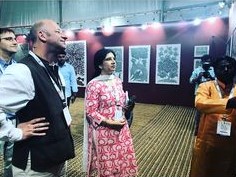
EARTH WARRIOR, A SHOW OF INDIAN FOLK AND TRIBAL ART FOR WORLD ENVIRONMENT DAY
India has a vast treasure of folk and tribal art forms, each possessing distinct cultural and regional characteristics. The highly symbolic Madhubani paintings, the ritualistic Pithora art of the Rathwa tribe, the engaging simplicity of Warli art, the sinuous lines of Kalighat paintings, the compelling stories of Rajasthani phads and West Bengal patachitras – these are just a few of India’s many folk and tribal art treasures. These art forms serve many functions – social, ritualistic, religious, story-telling, educational, entertainment. These paintings were means of visual education, a way of passing down stories, myths and social values from one generation to another. Above all, these art forms are very beautiful and aesthetic expressions of human creativity.
At the heart of most folk and tribal art traditions is the deep sense of respect for Mother Earth. These communities live in total harmony with the forces of Nature and worship our blue planet as a mother. Folk and tribal art in India reflects the inter-connectedness of all life forms on earth. These artists have a legacy of using eco-friendly materials with great beauty and felicity to create objects for daily use, veneration and contemplation. In most folk and tribal art traditions, even the colours are painstakingly extracted from roots, shoots, leaves and flowers and then mixed with a fruit glue to form bright hues. Through their art, the folk and tribal artists communicate a sense of reverence for Nature and for all life-forms.
Today, our country is plagued by the problem of garbage and litter. India is practically choking on the vast amounts of plastic waste generated in the country. Our fields and roads lie submerged in plastic garbage, our waterways and rivers are choked with plastic debris and everywhere you look there is more plastic trash to see. Our air, land and water are heavily polluted and we need to look for solutions, especially when it comes to taking personal responsibility for the state of the environment.
This show proposes to look at the issue of environmental pollution as seen by the folk and tribal artists of India whose lives traditionally were very earth-friendly. How do these artists respond to the scourge of plastic pollution that is now a part of our daily lives in India? How do they depict their concern for the environment through their art? What remedies or alternative use for plastics do these artists with their deep roots in pro-earth living have to offer?
Artists from various traditions – Gond, Madhubani, Jogi, Kalighat, pattachitra as well as sculptors in paper-mache and terracotta and wood have been invited to participate in this show. Artists from tribal communities in Northeast India are also being invited to create works based on their native skills- basketry and weaving – for this show.
Display View
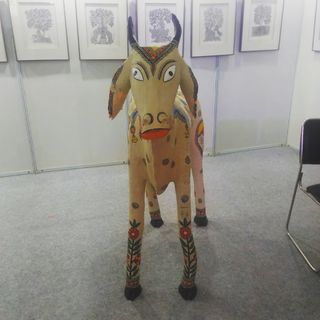
EARTH WARRIOR, A SHOW OF INDIAN FOLK AND TRIBAL ART FOR WORLD ENVIRONMENT DAY
India has a vast treasure of folk and tribal art forms, each possessing distinct cultural and regional characteristics. The highly symbolic Madhubani paintings, the ritualistic Pithora art of the Rathwa tribe, the engaging simplicity of Warli art, the sinuous lines of Kalighat paintings, the compelling stories of Rajasthani phads and West Bengal patachitras – these are just a few of India’s many folk and tribal art treasures. These art forms serve many functions – social, ritualistic, religious, story-telling, educational, entertainment. These paintings were means of visual education, a way of passing down stories, myths and social values from one generation to another. Above all, these art forms are very beautiful and aesthetic expressions of human creativity.
At the heart of most folk and tribal art traditions is the deep sense of respect for Mother Earth. These communities live in total harmony with the forces of Nature and worship our blue planet as a mother. Folk and tribal art in India reflects the inter-connectedness of all life forms on earth. These artists have a legacy of using eco-friendly materials with great beauty and felicity to create objects for daily use, veneration and contemplation. In most folk and tribal art traditions, even the colours are painstakingly extracted from roots, shoots, leaves and flowers and then mixed with a fruit glue to form bright hues. Through their art, the folk and tribal artists communicate a sense of reverence for Nature and for all life-forms.
Today, our country is plagued by the problem of garbage and litter. India is practically choking on the vast amounts of plastic waste generated in the country. Our fields and roads lie submerged in plastic garbage, our waterways and rivers are choked with plastic debris and everywhere you look there is more plastic trash to see. Our air, land and water are heavily polluted and we need to look for solutions, especially when it comes to taking personal responsibility for the state of the environment.
This show proposes to look at the issue of environmental pollution as seen by the folk and tribal artists of India whose lives traditionally were very earth-friendly. How do these artists respond to the scourge of plastic pollution that is now a part of our daily lives in India? How do they depict their concern for the environment through their art? What remedies or alternative use for plastics do these artists with their deep roots in pro-earth living have to offer?
Artists from various traditions – Gond, Madhubani, Jogi, Kalighat, pattachitra as well as sculptors in paper-mache and terracotta and wood have been invited to participate in this show. Artists from tribal communities in Northeast India are also being invited to create works based on their native skills- basketry and weaving – for this show.
Display View
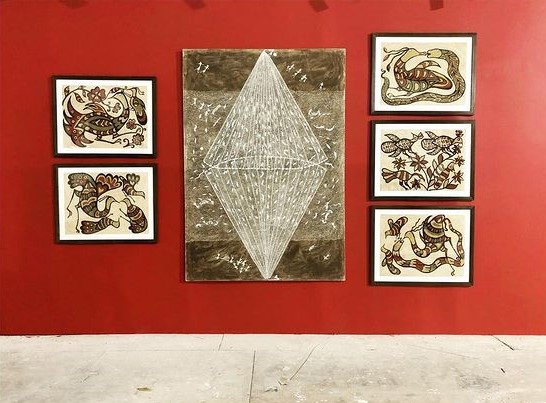
EARTH WARRIOR, A SHOW OF INDIAN FOLK AND TRIBAL ART FOR WORLD ENVIRONMENT DAY
India has a vast treasure of folk and tribal art forms, each possessing distinct cultural and regional characteristics. The highly symbolic Madhubani paintings, the ritualistic Pithora art of the Rathwa tribe, the engaging simplicity of Warli art, the sinuous lines of Kalighat paintings, the compelling stories of Rajasthani phads and West Bengal patachitras – these are just a few of India’s many folk and tribal art treasures. These art forms serve many functions – social, ritualistic, religious, story-telling, educational, entertainment. These paintings were means of visual education, a way of passing down stories, myths and social values from one generation to another. Above all, these art forms are very beautiful and aesthetic expressions of human creativity.
At the heart of most folk and tribal art traditions is the deep sense of respect for Mother Earth. These communities live in total harmony with the forces of Nature and worship our blue planet as a mother. Folk and tribal art in India reflects the inter-connectedness of all life forms on earth. These artists have a legacy of using eco-friendly materials with great beauty and felicity to create objects for daily use, veneration and contemplation. In most folk and tribal art traditions, even the colours are painstakingly extracted from roots, shoots, leaves and flowers and then mixed with a fruit glue to form bright hues. Through their art, the folk and tribal artists communicate a sense of reverence for Nature and for all life-forms.
Today, our country is plagued by the problem of garbage and litter. India is practically choking on the vast amounts of plastic waste generated in the country. Our fields and roads lie submerged in plastic garbage, our waterways and rivers are choked with plastic debris and everywhere you look there is more plastic trash to see. Our air, land and water are heavily polluted and we need to look for solutions, especially when it comes to taking personal responsibility for the state of the environment.
This show proposes to look at the issue of environmental pollution as seen by the folk and tribal artists of India whose lives traditionally were very earth-friendly. How do these artists respond to the scourge of plastic pollution that is now a part of our daily lives in India? How do they depict their concern for the environment through their art? What remedies or alternative use for plastics do these artists with their deep roots in pro-earth living have to offer?
Artists from various traditions – Gond, Madhubani, Jogi, Kalighat, pattachitra as well as sculptors in paper-mache and terracotta and wood have been invited to participate in this show. Artists from tribal communities in Northeast India are also being invited to create works based on their native skills- basketry and weaving – for this show.
Dsiplay View

